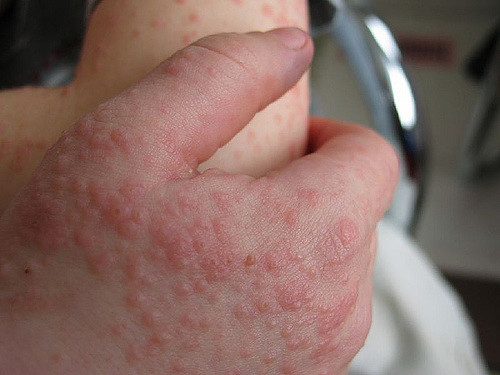If you are familiar with ‘mono’, then you should be familiar with Epstein-Barr virus. This is the virus behind mononucleosis or ‘the kissing disease’, as it is also called. This is because that is one way of giving it to someone else. There are plenty of people who carry the virus without suffering problems. But some people will develop rash when they are sick with the infection.

How Does Epstein-Barr Virus Rash Cause Rash?
With about 15% of those that have mononucleosis, there will be a rash. This can be a widespread, but light rash that lasts around 7-10 days. It is also known as maculopapular exanthem, and usually flat with small red spots. It tends to start on your torso and works its way to your arms. From there, it may spread to your forearms and face quickly. It may look like:
- Purpuric-looking like a bruise
- Popular-small bumps
- Vesicular or little blisters
- Morbilliform (measle-like) patches that are small
- Scarlatiniform tiny spots
Those with mono and an intense rash, tend to have one of the forms described above. Morbilliform or maculopapular rashes are external and tend to occur when a patient with mononucleosis is treated with cephalosporin, amoxicillin or ampicillin. It appears to be a hypersensitivity to the antibiotic. It should be treated with caution, but also note that it does not necessarily mean the person is generally allergic to these meds.
Other Possible Symptoms or Complications Besides Epstein-Barr Virus Rash
There are those that get the mono that comes with sore throat and also streptococcal infection. There are also times a person develops sinus infections or tonsil infections along with the illness. Mono itself, is associated with being tired until symptoms disappear.
Your body’s organs may also be affected by mononucleosis. You could have an enlarged spleen, hepatitis, arthritis, interstitial pneumonia, glomerulonephritis or pericarditis. In some extreme cases, a person can have their nervous system affected by the infection, causing transverse myelitis, bell’s palsy, meningoencephalitis or Guillian-Barre syndrome. The symptoms may include swollen eyelids, retinitis, uveitis, keratitis and conjunctivitis.
There are some cases that mononucleosis affects the blood system, producing symptoms of immunodeficiency, neutropaenia, autoimmune haemolytic anaemia, thrombocytopenia and cold agglutinins.
How to Deal With the Rash
Most of cases, theEpstein-Barr virus rash will leave on its own, but it’s nice to have soothing options available.
Antibiotics
If your rash is very itchy you may want to speak to your doctor about possible treatments. Antibiotics aren’t often recommended because they can make the rash worse. If your mono comes with strep throat or another secondary infection, antibiotics may be the only choice. Your doctor will need to do blood tests to confirm. This is the best way to insure you are getting proper treatment.
Anti-Inflammatory Herbs or Foods
You can try turmeric, ginger, or garlic for their anti-inflammatory properties. You can also enjoy pineapple or fish for the same benefits. It is important to drink at least 8 glasses of water to stay hydrated if you want the rash to go away.
Aloe Vera
Extracts from plants like aloe vera have been shown to be effective. Apply the substance from the plant directly to the rash several times a day. You can find the plant at garden centers and supermarkets. They are rich in vitamins C and E which will help to soothe and heal your rash.
Protecting Your Liver or Spleen
If your Epstein-Barr virus rash is raised and itchy, your liver may be affected. It is important to seek a doctor immediately. Liver issues should be suspected if the rash comes with headaches, nausea, poor appetite and other symptoms. You may also get a swollen spleen or liver with your mono. Therefore it’s often advised to sit sports out, so you don’t get an injury to your swollen organs.
How to Clear the Epstein-Barr Virus Infection
You already know the ways to treat the rash. Consider the following options in your quest to clear up the infection naturally within a few weeks.
- Get tons of rest.
- Drink 8 or more glasses of water and juice.
- Take cough drops, ice cubes, popsicles and gargle with salt water for relief.
- Bring fevers down with ibuprofen or acetaminophen.
- Ease back into your work routine and avoid heavy lifting so you don’t injury already swollen organs.
When to See Your Doctor
In the case of rare complications, it’s important to visit your physician. Check in with your doctor if you experience the following symptoms:
- Infrequent urination
- Sudden, sharp pain in the side
- Trouble swallowing or breathing
If your symptoms aren’t gone in a few weeks, you should revisit the doctor. This is because you could have something else besides mono.
Prevention
There is no vaccine for the virus. Be vigilant in prevention, if you know someone that has it, avoid their saliva and wash your hands after contact. It’s best to avoid them altogether until they are healthy again.